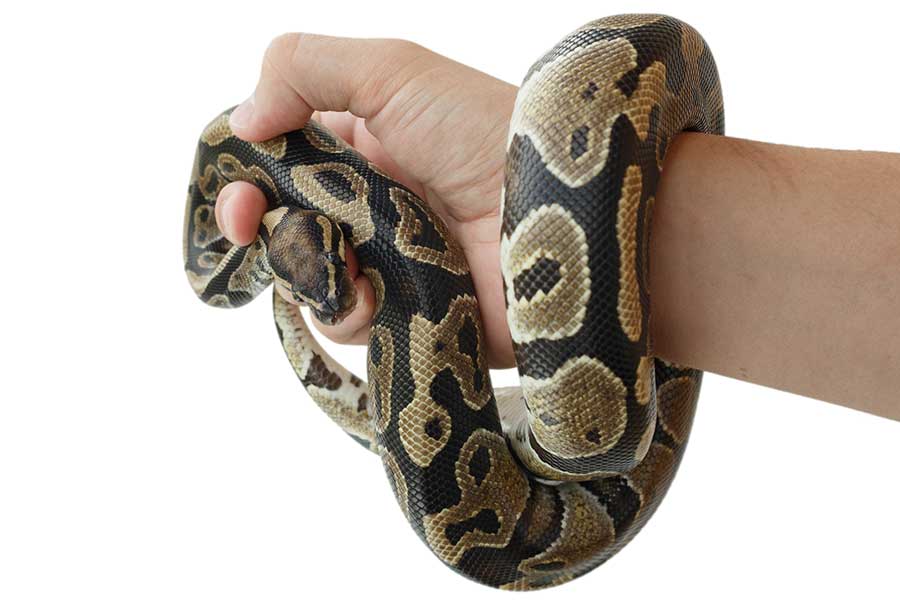What are the main differences between male vs female ball pythons?
Unlike birds, male and female ball pythons (and most snakes in general) do not present with different colors or plumage to make it easy for us to tell them apart. Determining a ball python gender can be tricky.
However, it is possible to tell the sexes apart, and you can do so without probing them or seeking the help of a veterinarian or breeder! Probing snakes always runs a risk of damaging their internal organs and should be avoided by everyone except trained professionals.
This article will help you figure out whether your ball python is male or female just by looking at a few of their physical characteristics and plopping them on a scale.
Read on to find out the three key differences between male and female ball pythons, how to look for them, and if male or female ball pythons make better pet snakes.
Male vs Female Ball Pythons: Key Differences
The main differences between male and female ball pythons are:
- Size: Male ball pythons are smaller in size, whereas females are thicker and heavier.
- Spur Size Male ball pythons have more pronounced anal spurs, whereas female spurs are much smaller.
- Tails: Male ball pythons have wider tails with short, square, blunt tail ends, whereas female ball pythons have longer and pointier tails.
Male and female ball pythons are very similar, and without looking for these subtle differences, you would not know the difference in terms of behavior!
However, if you need a breeding pair, then obviously having a male and female snake is essential!
How to Sex a Ball Python
If you don’t know your ball python’s age or what differentiating traits to look for, it is practically impossible to tell the difference between male and females of the species.
Males and females share similar personality traits and behavioral patterns, so the true differences in ball python male vs female come down to 3 physical clues: size, spurs and tails.
Appearance and Size
Ball pythons are sexually dimorphic. This means there are some slight physical differences between the males and females.
Typical of most snake species, the male ball python is actually smaller than the female. The table below lists the average size and weight for female and male ball pythons according to their ages.
Size Chart: Average Size and Weight for Pythons by Age
In only approximately 14% of all snake species, males are larger than females! In the case of ball pythons, males are smaller than the females.
When it comes to how this affects their care in captivity, female pythons require slightly larger enclosures than males.
Unless you know precisely how old your snake is and what kind of diet you’ve been offering them, it may be almost impossible to determine their sex by size alone.
You will have to decide what ultimate size snake you are willing to deal with in the long run. If you want a slightly smaller ball python, then a male would be best to get. However, if you want a six-foot ball python, then make sure you are getting a female!
As a general rule, you want to allow 10 gallons of tank per each foot of snake. So if you have a female python that’s 60 foot long then you’ll need a 60 gallon tank.
Learn more about ball python setup and care.
Anal Spurs
Once upon a time, ball pythons’ ancestors actually had hind legs! Their anal spurs (also referred to as pelvic spurs or cloacal spurs) are what is left over of those legs after many thousands of years of evolution.
Anal spurs are bony protrusions on either side of the cloaca. The cloaca is a small opening located at the end of your snake’s body and beginning of their tail. These spurs are very pronounced on old world snakes such as our ball pythons and boas.
Male Anal Spurs
Most male ball pythons will have larger anal spurs than females. Some males are even able to move these spurs. They also use these spurs to grip onto females while mating.
However, sometimes, these spurs will be small or almost nonexistent, even on males! You cannot rely on them alone to determine a snake’s sex.
Female Anal Spurs
Female ball pythons also often have anal spurs. These spurs are generally much smaller and less prominent than male’s anal spurs, and they are much softer and less rigid. Females are usually unable to move their spurs freely.
There has been some speculation that ball python females use these spurs to hold onto prey; however, this is very unlikely and has been subject to much debate considering how small and weak the spurs are.
Anal spurs are not a hard and fast rule when it comes to determining sex in ball pythons. They are unique to the snake itself, so some female ball pythons may have very large and pronounced anal spurs. It also isn’t terribly uncommon for males to have very small ones.
Therefore, you should not rely solely on the appearance of your snake’s anal spurs to determine their sex. Always use all three indicators of sex listed here together to come to an informed decision.
Tail Thickness
Male and female ball pythons have distinct bodies and tails.
The body of a ball python houses all of the snake’s internal organs and important parts of their nervous, digestive, skeletal, and other crucial body systems. The cloaca is located at the end of the snake’s body where their tail begins. The cloaca is the multipurpose entry and exit hole for reptiles where the reproductive organs can be found.
Ball pythons poop, pee, lay eggs, give birth, and mate all through their cloacas.
From their cloacas onward is all tail. A ball python’s tail is primarily made up of muscle and fat. The shape of this part of their body can help you determine the snake’s sex.
Male Python Tail
Male ball python’s will typically have a fatter or thicker tail right after the cloaca. It is bigger here because this is where the snake’s hemipenes are stored. Hemipenes refer to the two penises that the male ball python mates with.
The hemipenes are the two penises that ball pythons use to mate with. There are two of them so that no matter what side of the female’s tail the male ends up on, he will have success!
After the cloaca, the tail will start to narrow down and it will end in a blunt, square tip.
Female Python Tail
A female ball python’s body ends at the cloaca just like the male’s. However, there is no thickening at this point because there are no hemipenes stored inside. The female’s tail usually tapers off after her cloaca to a delicate point at the end rather resembling than the male’s more blunt, square tail tip.
It is difficult to tell the difference between the two tail shapes unless you have a male and a female ball python right next to each other to compare their tails or you are very experienced at ball python husbandry and are able to recognize them.
If you’re struggling to tell if a ball python is male or female, visit your local reptile vet. They will be able to analyse the snake’s sex organs with a probe rod (using a method called popping or probing) and give you a definitive answer about their sex.
Did you know that scientists recently discovered that some snakes have clitorises, known as a hemiclitoris.

Male vs Female Ball Pythons: Is One Better Than the Other?
The three key differences between ball python male vs female are their body sizes, the presence and appearance of their anal spurs, and the shape of their tails. The best snake for you will ultimately come down to the size of the snake you want. Female snakes tend to be larger, but they also require slightly larger enclosures.
If you want a ball python because they make great pets, are easy to handle, and are simple to take care of, then figure out how much space you are willing to devote to it. If you can only manage a 40 gallon enclosure, then you should definitely get a male.
Read our Ball Python Growth Rate Guide for more information about how big your ball python will get.
FAQs About Male and Female Ball Pythons
Are female ball pythons nicer than males?
There are no personality or behavioral differences between female and male pythons. One sex is not nicer or easier to look after than the other.
Can I house two male ball pythons together?
Male ball pythons are not typically territorial outside of mating time, but some males get stressed out by sharing an enclosure with another snake. It’s possible to house two of them together, but their enclosure needs to be increased by at least 10 gallons for each snake.
In addition to the size increase, there needs to be the same number of hides as there are snakes as well as a larger
The two snakes also must not be fed together. While they may not be competing for food, ball pythons’ prey drives are high, and they may bite one of their housemates by accident.
All of these rules apply to female ball pythons, too! It’s generally best to avoid cohabitation unless you are an experienced reptile keeper, but it is possible.
Can I house a male and female ball python together?
When you house a male and female snake in the same enclosure, you run the risk of accidental babies! Unless you are planning on breeding your ball pythons, you shouldn’t house males and females together.
Is there a difference in husbandry for male and female ball pythons?
The enclosure setup, handling routines, and general care requirements of male and female ball pythons are identical. The main difference in care will be the size of the enclosure.
Adult ball pythons in general need a 40+ gallon enclosure at the absolute minimum, but since female pythons are slightly larger than males, they do best in 60+ gallon enclosures.The only real difference in care between the two sexes is the need for additional metabolic bone disease.
Balling Off…
There are no real personality differences or temperament differences when it comes to male vs female ball pythons. The biggest difference and the one that matters the most is the ultimate size they will grow to as adults.
Adult females are typically much larger than adult males, which impacts the size of the enclosure they need to be housed in as well as the size or quantity of the food they eat. Female ball pythons also need additional
If you want a huge, six-foot pet python, then go with a female. However, if you want a smaller, perhaps three- or four-foot long snake that loves a good handling session and is a tiny bit simpler to house and care for, then go for a male ball python!


